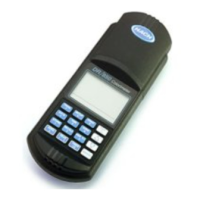151
CHLORINE DIOXIDE, continued
Accuracy Check
Because chlorine dioxide is difficult and hazardous to produce,
check the DPD and glycine reagents by using chlorine standards.
Proceed as follows:
1. Prepare a 1-mg/L free chlorine standard.
Method 1
a. Obtain Free Chlorine Standards, (Cat. No. 14268-10).
b. Determine the concentration of the standard from the
certificate of analysis shipped with the standard
(50-75 mg/L). Calculate the volume of standard needed
as follows:
mL standard needed = 100 ÷ standard concentration
c. Pipet the volume of standard needed into a 100-mL
volumetric flask. Dilute to the line with chlorine
demand-free deionized water. Invert to mix.
Method 2
a. Dilute 1 drop of commercial 5% chlorine bleach in 1 liter
of chlorine demand-free deionized water. Use this as the
standard.
2. Verify the standard’s concentration using the Hach Free
Chlorine Method, #8021.
3. Perform the chlorine dioxide test on the standard without
adding glycine (step 6).
4. The chlorine dioxide reading should be about 2.45 times
greater than the chlorine result. If so, this verifies the DPD
and the instrument are functioning properly.
5. Repeat the chlorine dioxide test on the chlorine standard,
including the glycine addition (step 6). The reading should be
less than 0.10 mg/L. This verifies that the glycine is
eliminating free chlorine interference.

